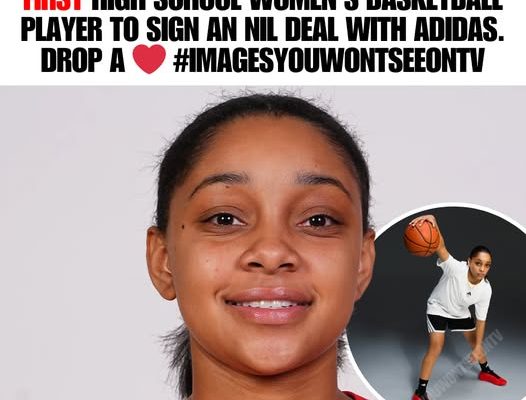Kaleena Smith, a 16-year-old point guard from Ontario, California, has officially carved her name into basketball history, becoming the first high school women’s basketball player to sign a name, image, and likeness (NIL) deal with Adidas under the leadership of Candace Parker. This groundbreaking moment not only marks a personal milestone for Smith but also signals a significant shift in the way major athletic brands are approaching the women’s basketball landscape, especially at the high school level. With her remarkable talent, elite status as the top 2027 recruit in the country, and an already growing list of powerhouse programs courting her, Smith’s rise is a story that blends athletic excellence, brand vision, and the evolution of opportunities for young women in sports.
From the very beginning of her basketball journey, Smith has stood out as a generational talent. Her ability to dictate the pace of a game, read defenses, and create scoring opportunities both for herself and her teammates has drawn comparisons to some of the greatest point guards in the sport’s history. At just 16, she has already displayed a level of maturity and skill set that makes her not only a dominant player at the high school level but also a prospect destined to impact the collegiate and professional game. Her vision, handles, court awareness, and scoring versatility set her apart from her peers, and it’s no wonder that schools like UCLA, UConn, and LSU have already made her a recruiting priority. These programs are known for producing WNBA stars and championship-caliber teams, and adding someone like Smith would be a major coup for any of them.
The historic NIL deal with Adidas under Candace Parker’s leadership represents more than just a personal endorsement for Smith; it is a symbolic moment for women’s sports. Parker, a two-time WNBA champion and one of the most respected figures in basketball, has been instrumental in expanding opportunities for female athletes. Since taking on a leadership role with Adidas, Parker has made it clear that she wants to create pathways for young women to thrive not only on the court but also in the business of sports. For Adidas to bring in Smith as their first high school women’s basketball NIL signing under Parker’s watch sends a strong message: the company is willing to invest early in generational talent and use its platform to elevate the visibility of women’s basketball.
For Smith, the partnership with Adidas is a dream come true, not only because of the financial and brand exposure it brings but also because of what it represents in terms of mentorship. Having Parker as a guiding figure offers her invaluable insight into navigating a basketball career at the highest levels. Parker’s journey from a top recruit to a WNBA legend is the blueprint many young athletes aspire to follow, and now Smith has direct access to that wealth of knowledge. It’s a rare opportunity for a high school athlete to receive that level of support from a global brand and a sports icon at such an early stage of her career.
The timing of this deal also coincides with a larger cultural shift in how NIL is reshaping the athletic landscape. Until recently, high school athletes were largely excluded from these types of opportunities, but recent changes in regulations across several states have opened the door for elite young players to monetize their personal brands before they even step onto a college campus. While the NIL market has been booming in men’s sports, particularly football and basketball, this move by Adidas highlights that women’s sports are entering a new era of commercial viability. By securing an athlete like Smith so early, Adidas positions itself to build a long-term relationship with one of the sport’s future superstars while also inspiring other brands to invest in young women’s talent.
Recruitment-wise, Smith’s stock was already sky-high before this announcement, but now it’s likely to soar even further. Top programs understand that a player of her caliber brings more than just elite basketball skills; she brings star power, marketability, and the potential to elevate an entire program’s profile. UCLA, with its deep basketball tradition and proximity to her hometown, has been a natural contender from the start. UConn, the gold standard of women’s college basketball under Geno Auriemma, offers the appeal of national titles and a legacy of producing WNBA legends. LSU, fresh off its recent surge in prominence under Kim Mulkey, has proven it can compete for championships and develop stars in the NIL era. Each of these programs would offer Smith a unique platform, but whichever direction she ultimately chooses, the impact will be felt immediately in both the basketball and marketing worlds.
What makes Smith’s journey so compelling is that she has managed to balance the increasing demands of being a national sports figure while remaining grounded and focused on her development as a player. Those close to her often speak about her relentless work ethic, her attention to detail, and her commitment to improving every facet of her game. Even as the spotlight grows brighter, she remains the type of player who stays late after practice, perfecting her jump shot and working on her conditioning. This mindset not only bodes well for her transition to the next levels of basketball but also reflects the type of character that brands like Adidas want to be associated with.
The influence of this deal will likely ripple beyond just Smith’s personal career. For other young female athletes, it serves as a powerful example that major endorsement opportunities are no longer reserved for professionals or college standouts. It shows that talent, hard work, and marketability can open doors much earlier than ever before. For the sport of women’s basketball, it’s yet another indicator that the game is growing in visibility, market value, and cultural significance. The presence of a high school athlete in a global brand campaign not only inspires future generations but also challenges the industry to continue providing resources and support for young women at all levels.
Candace Parker’s role in this cannot be overstated. Her vision for expanding women’s basketball visibility aligns perfectly with Adidas’s strategy of identifying and nurturing talent early. By backing Smith, Parker isn’t just endorsing a talented player; she’s making a statement about the importance of building the sport’s future now. Parker herself was once a highly touted recruit who faced the pressures of living up to immense expectations, so she understands exactly what Smith will encounter in the coming years. That shared experience creates a natural mentor-mentee dynamic that could be pivotal in guiding Smith through the unique challenges of her emerging career.
For Smith, the focus now remains on continuing to dominate at the high school level while preparing for the transition to the college game. The NIL deal, while groundbreaking, is just one part of a larger picture that includes development, recruitment, and eventually making her mark at the collegiate and professional levels. She has already demonstrated that she can handle the demands of being in the national spotlight, and with her combination of skill, poise, and support from figures like Parker, she is well-positioned to not only meet expectations but exceed them.



